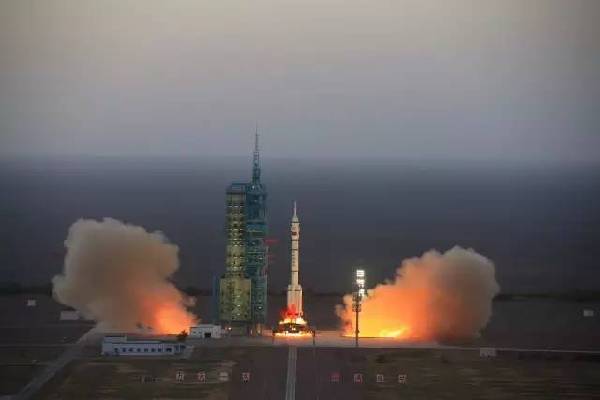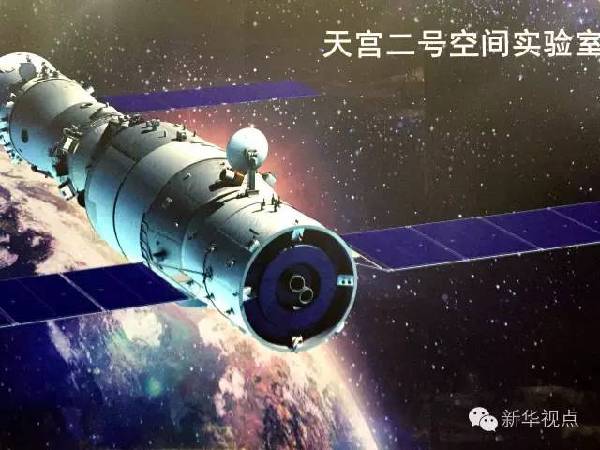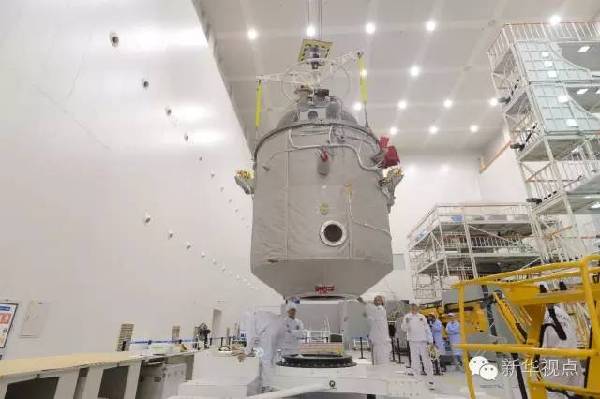In front is the heavenly palace,
Followed by shenzhou.
They are the brightest stars in the sky tonight.
They are said to be "awesome",
Where is "awesome"?
11 details to decrypt for you.

On October 17th, astronauts Jing Haipeng and Chen Dong of Shenzhou XI manned mission went to war. Xinhua News Agency reporter Li Gangshe
Detail 1: Fly higher — — Docking and operation of 393 km track height
Shenzhou 11 has fully inherited the technical status of Shenzhou 10, and made many technical improvements to meet the requirements of this mission.
"In order to meet the requirements of this mission, the orbit control strategy and flight procedures have been adjusted, so that the Shenzhou 11 spacecraft can adapt to the requirements of the rendezvous and docking orbit and the return orbit height of this mission from 343 km to 393 km." Wu Ping, deputy director of China Manned Space Engineering Office, said.

When Shenzhou-10 docked with Tiangong-1, the orbital height was 343 kilometers. When Shenzhou XI and Tiangong II docked, the orbital height was 393 kilometers, which was 50 kilometers higher than in the past. Why should it be 50 kilometers higher? Luo Guqing, director of the GNC subsystem of the Fifth Academy of Aerospace Science and Technology Group, said that it is mainly for the third step of China’s manned space flight "three-step" development strategy — — Prepare for the construction of the space station, because it is basically the same as the orbital height of the future space station, and the flight is closer to the requirements of the future space station.
Detail 2: It takes longer — — A 33-day space journey
After two days of independent flight, Shenzhou XI completed automatic docking with Tiangong 2 to form an assembly. After completing the 30-day mid-term stay of the assembly, it separated from Tiangong 2 and returned to the main landing site in Inner Mongolia within one day, and the Shenzhou XI mission ended. Being in space for a long time, how to ensure the astronauts’ ability to work and live in space and perform tasks, and how to improve the reliability of the spacecraft?

One of the most important innovative highlights of the technical improvement of Shenzhou XI is the newly equipped wide-beam relay communication terminal equipment.
"In order to further improve the safety and reliability, a new wide-beam relay communication terminal equipment has been equipped, which has significantly expanded the coverage of measurement and control and improved the communication support capability between heaven and earth when the attitude of the spacecraft changes rapidly, thus improving the safety of astronauts and the reliability of the spacecraft." Wu Ping said.
Detail 3: Upgrade the optical imaging sensor — — Complete the difficult "kiss in space"
"In order to verify the future space technology and meet the long-life requirements of the rendezvous and measurement equipment of the future space station, the rendezvous and measurement equipment of Shenzhou 11 was upgraded." Wu Ping said.
The rendezvous and docking of Tiangong-2 and Shenzhou-11 is an important step to build a space home, especially the stage from the distance of 120 meters to the final docking, which is the most difficult and risky. In order to make them butt together at eight times the speed of bullets, technicians upgraded the optical imaging sensor.

Gong Dezhu, chief designer of the optical imaging sensor for the Shenzhou 11 rendezvous and docking, said that the sunlight intensity in space is three to five times that on the earth, so it is easy to "light up" the "eyes" of the aircraft, just like driving when the headlights are shaken by the opposite car, and it will take some time to restore vision. Therefore, in the past, the rendezvous and docking should be carried out at the right time.
Compared with the first generation of products used on Tiangong-1, the ability of the upgraded sensor to suppress solar stray light and the sensitivity of identifying targets are greatly improved. Even if the eyes are shaken, the vision recovery time can be shortened from the original ten seconds to several hundred milliseconds. As a result, Shenzhou XI and Tiangong II can realize quasi-all-weather real-time docking, which can guarantee the sudden maintenance and replenishment of spacecraft or the emergency rescue of astronauts.
Detail 4: First assessment of astronauts’ medium-term staying ability
"The purpose of this mission is to further comprehensively verify the functions of the improved manned spacecraft and provide important technical support for subsequent manned missions. In addition, through a number of on-orbit tests, the design function of the spacecraft will be further verified, and flight test data related to the manned environment will be obtained and accumulated. " Zhang Bainan, chief designer of Shenzhou XI spacecraft, said.
In this space laboratory mission, the height of docking orbit and return orbit has increased by 50 kilometers compared with before. The Shenzhou XI mission will examine and verify the rendezvous and docking technology and manned spacecraft return technology in the space station stage for the first time, and will also examine the astronauts’ medium-term staying ability for the first time, which will lay the foundation for the long-term on-orbit assessment in the space station stage by verifying the astronauts’ staying ability.
Detail 5: Lighting equipment lights up "Flying Road"
Shenzhou XI will pass through the earth’s shadow area periodically during its voyage in the vast universe, and it will go through a long period of darkness at this time, which will affect the smooth completion of the on-orbit mission. The lighting equipment in the spacecraft cabin and the rendezvous and docking lighting equipment not only provide the astronauts with working and living lighting in the cabin, but also provide camera-assisted lighting for the rendezvous and docking of the manned spacecraft and the space laboratory in the shadow area.
"In space, if incandescent lamps and energy-saving lamps commonly used in life are directly used, it is estimated that they will turn off in a few days on the spacecraft. What light source is used on the spacecraft? The lighting equipment (short-range floodlighting) and rendezvous and docking lighting equipment (long-distance projection lighting) in the Shenzhou 11 spacecraft use LED light sources, that is, solid-state lighting sources. " Yang Jun, chief designer of 510 products in the Fifth Academy of Aerospace Science and Technology Group, who undertook the task of developing this equipment, said.
He pointed out that after the manned spacecraft has the lighting equipment in the cabin and the rendezvous and docking lighting equipment, when the spacecraft enters the earth’s shadow area, the astronauts can still correctly interpret the instruments in the cabin and manually operate various switches, so that they will never hit by mistake again. The rendezvous and docking between the spacecraft and the space laboratory has also gained a successful guarantee.
Detail 6: Thermal control system escorts "Space House"
"The most important thing for Shenzhou XI to fly in space is the safety of astronauts." Fu Yang, head of the thermal control subsystem of the Shenzhou 11 launch site of the Fifth Academy of Aerospace Science and Technology Group, said that to ensure the comfort and safety of astronauts in space, it is necessary to create a "home" similar to the ground for astronauts — — There are temperatures and oxygen suitable for human survival and life, which are provided by the thermal control subsystem and the environmental control life support system. The thermal control subsystem is used to maintain a certain temperature and humidity in the spacecraft, and the environmental control life support system is used to create suitable indoor living environment conditions for astronauts, ensure their safe life and normal work in the special environment of space flight, and create a warm and spring-like living environment for astronauts.
He said that the thermal control subsystem and the environmental control life support system are located in the bulkhead of the propulsion module and the orbital module of the manned spacecraft respectively. The environmental control and thermal control subsystem mainly adopts fluid heat exchange technology to control the temperature. The heat generated on the ship is transferred to the external radiator through fluid flow, and then radiated into space through the radiator.
Detail 7: hatch rapid leak detector — — "Little Door God" of Manned Spacecraft
Astronauts fly in space for many days, during which they have to go through many cabin-crossing activities and need to open and close the hatch; When astronauts are in the cabin, the gas that maintains their normal life cannot leak, and whether the hatch is well sealed is decisive, so it is very important to accurately and quickly detect the tightness of the hatch.
Early spacecraft used the whole cabin pressure to detect the tightness of the cabin door by monitoring the change of cabin pressure. This method is accurate and reliable, but it takes a long time, which has a great impact on the astronauts of manned spacecraft and will waste a lot of time. Therefore, it is necessary to improve the detection means and shorten the detection time.
The rapid leak detector of the hatch developed by 510 Institute of the Fifth Academy of Aerospace Science and Technology Corporation realizes the rapid and accurate leak detection of the hatch and docking surface. After the door is closed, a small space will be formed between the two sealing rings on the door body and the door frame. The leak detector uses the unique structure of the cabin door to fill a certain amount of detection gas into the small space when working, and judges the sealing condition of the cabin door by monitoring the pressure change in the small space. In case of leakage, the hatch rapid leak detector will immediately give an alarm indication. Astronauts can handle the hatch and pass the leak detection again before they can stay in the cabin smoothly.
"The hatch rapid leak detector can quickly give the test results within 8 minutes, which is called the ‘ of manned spacecraft; Little door god ’ 。” Dong Yipeng, chief designer of 510 products in the Fifth Academy of Aerospace Science and Technology Corporation, said.

Detail 8: Dashboard Shock Absorber — — "Life jacket" of spacecraft instrument
Instrumentation devices on spacecraft complete human-computer interaction through LCD screen and astronauts. Instrumentation devices, as representatives of high-tech technologies, are often fragile, and the instantaneous rapid acceleration of rockets during launch will cause severe vibration of equipment in spacecraft cabin. If the impact vibration during launch cannot be well isolated and attenuated, it is likely to lead to instrument damage and mission failure.
At this time, the instrument panel shock absorber of Shenzhou series spacecraft shoulders the heavy responsibility of damping the instrument of the whole spacecraft. Metal rubber shock absorbers installed at four installation points of the instrument panel isolate the instrument from the hull, and consume a lot of energy through constant friction between wires during vibration, which eventually turns into heat energy and disappears into the surrounding medium.
Experts pointed out that the metal rubber shock absorber perfectly played the role of "life jacket" of shenzhou spaceship instrument devices, ensuring the complete success of previous missions.
Detail 9: The magic "coat" of manned spacecraft
Shenzhou 11 runs in an orbit about 400 kilometers above the earth’s surface, where it will be affected by the radiation of the sun, the radiation and reflection of the earth-atmosphere, and many high-energy particles floating in space. In such an environment, how can a spaceship better protect itself?
Fu Yang said that the magical "coat" they designed for the spacecraft.
Just like human clothes, they can keep warm when it is cold, protect against the sun when it is shining, and at the same time, clothes can isolate the harm of harmful factors such as dust and smog to the skin.
Researchers from the Fifth Academy of Aerospace Science and Technology Group have designed a coat with a thickness of about 2 cm for the orbital module, which can effectively isolate the heat exchange between the space environment and the bulkhead of the orbital module. There is also a gorgeous composite film on the surface of the coat to improve the spacecraft’s protection against particles such as orbital atomic oxygen. A specially designed organic thermal control coating is sprayed on the outer surface of the return capsule, which provides strong support for ensuring the temperature conditions of the return capsule during the on-orbit period.
At the bottom of the propulsion cabin, in order to effectively suppress the influence of high temperature after engine ignition on the propulsion cabin, multiple layers of heat insulation materials are used in this key area, and the highest temperature that can be isolated can reach 900℃.

The top of the rocket is called the "tower of life" of astronauts (photo taken on October 17). Xinhua News Agency reporter Liu Shiping photo
Detail 10: Escape Engine — — Astronauts’ "reassurance" of patrolling the sky
People who have seen shenzhou spaceship launch will notice that there is a steeple-like device similar to a lightning rod at the top of the rocket, which is an escape and rescue system independently developed by the Fourth Institute of Aerospace Science and Technology Group and called the "tower of life" for astronauts.
Yu Hailin, commander-in-chief of the escape engine of the Fourth Academy of Aerospace Science and Technology Group, said that the escape system bears the mission of astronauts’ safety and lifesaving, and it is one of the three major technical difficulties that China’s manned spaceflight project must break through. The escape and life-saving system successfully developed by the people of the Fourth Hospital overcame difficulties, which provided safety guarantee for astronauts to survey the sky with confidence.
According to Yu Hailin, the escape tower has special performance and complex technology, and only the United States and Russia have mastered this technology in the world.

Detail 11: the magic weapon for the safe return of the spacecraft
Recovery landing is the last step of manned space activities, and it is also the last stick to determine whether astronauts can go home safely.
Rong Wei, shenzhou spaceship, deputy chief designer of the Fifth Academy of Aerospace Science and Technology Group, said that the 508 Institute of the Fifth Academy was responsible for the development of the shenzhou spaceship recovery landing system, and has successively overcome key technologies such as oversize parachute, landing buffer, static pressure parachute opening height control, multi-mode recovery program control, and non-fly-by-wire bomb cover opening, and developed a set of spacecraft recovery landing system with the highest recovery quality, the lowest landing speed, the highest reliability and safety and the most complicated system in China.
He said that the bright spot of Shenzhou XI’s recovery and landing is obvious. First, it is the first large parachute in China. Parachute system is an important aerodynamic deceleration device in the spacecraft’s return phase, which can reduce the spacecraft’s return cabin entering the atmosphere from the speed of high-speed rail to the speed of ordinary people jogging. The system consists of more than 7,000 parts, which is the largest and most complicated system in the parachute recovery of spacecraft in China. Among them, the main umbrella is 1200 square meters, which can cover a football field. The second is the landing buffer technology to improve ride comfort. After "soft" friction with the air, the spacecraft’s return capsule entered the landing buffer, and the last step was a hard-hitting collision. In order to keep the astronauts’ good ride experience even when the spacecraft "landed", the researchers applied the landing buffer technology to the landing buffer system of the shenzhou spaceship return capsule, thus realizing the "soft landing" of the return capsule. (Source: Xinhua News Agency’s all-media reporting platform, Xinhua Viewpoint Producer: Li Daixiang Reporter: Liu Shiping, Li Guoli, Chen Xi, Wei Hua, Xiao Sisi Video: Yang Shiyi, Cao Jiangtao, Li Nan, Chen Xi)